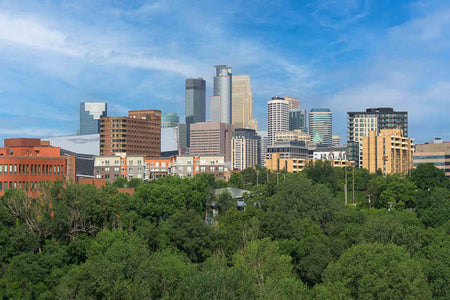Living in New Mexico can be a wonderful experience with its beautiful landscapes and vibrant culture. However, for some individuals, the unique environment of New Mexico can also bring about challenges when it comes to allergies. Understanding how these allergies can affect your health is crucial for managing symptoms and maintaining overall well-being.
Seasonal allergies are quite common in New Mexico due to the diverse plant life and varying climate throughout the year. The high pollen count during certain seasons can trigger symptoms such as sneezing, itchy eyes, and congestion for many residents. It's important to be aware of the specific allergens in the region, such as juniper, sagebrush, and cottonwood, in order to take necessary precautions.
For those who experience allergies, there are several ways to alleviate symptoms and improve quality of life. Regularly checking pollen forecasts, using air purifiers indoors, keeping windows closed during peak pollen times, and wearing a mask when doing outdoor activities can all help reduce exposure to allergens. Additionally, over-the-counter antihistamines and nasal sprays can provide relief for milder symptoms, while consulting with a healthcare professional can offer personalized treatment options for more severe allergies.
By staying informed about common allergens in New Mexico and taking proactive steps to manage allergies, individuals can continue to enjoy all the beauty and richness this state has to offer without being hindered by seasonal allergies.
New Mexico Allergy Season
Understanding the different allergy seasons can help you better manage your symptoms and enjoy the beautiful state without the constant sneezing and itching.
Spring: Pollen Galore
Spring in New Mexico brings an explosion of pollen from trees, grasses, and weeds. This can trigger allergies in many individuals, leading to symptoms like sneezing, itchy eyes, and congestion. Approximately 20% of people in New Mexico suffer from spring allergies.
Summer: Dust and Mold
As the temperatures rise in the summer, so do the levels of dust and mold in the air. These allergens can exacerbate respiratory issues and cause discomfort for those sensitive to them. Around 15% of New Mexicans experience summer allergies.
Fall: Ragweed Season
Fall in New Mexico is ragweed season, with this pesky plant releasing pollen that can trigger allergic reactions in many people. Ragweed allergies affect approximately 25% of the population in the state.
Related: Fall Allergies Guide
Winter: Indoor Allergens
During the winter months, New Mexicans spend more time indoors, where allergens like dust mites, pet dander, and mold thrive. This can lead to year-round allergy symptoms for some individuals, affecting around 30% of the population.
Common New Mexico Allergens By Region
In New Mexico, the diverse landscape and climate create a unique environment that can lead to a variety of allergens affecting residents. Let's explore the common allergens found in different regions of the state.
Northern New Mexico
In the northern part of the state, high altitude and cooler temperatures can contribute to different allergens compared to other regions. Pollen from juniper, cedar, and pine trees are prevalent in this area, leading to seasonal allergies for many residents. Additionally, mold spores can be a common allergen, especially in damp or humid conditions.
Central New Mexico
Central New Mexico, including Albuquerque and surrounding areas, experiences a mix of desert and urban environments. Dust and pollen from native plants like sagebrush and tumbleweed can trigger allergies in this region. Air pollution from traffic and industrial sources can also exacerbate symptoms for allergy sufferers.
Southern New Mexico
The southern part of the state, with its arid climate and agricultural areas, presents its own set of allergens. Dust storms are a common occurrence, leading to increased levels of dust mites in the air. Pollen from grasses and weeds, as well as agricultural pesticides, can also contribute to allergies in this region.
Related: Grass Rash: Causes, Symptoms, and Treatment
Eastern New Mexico
Eastern New Mexico, with its flat terrain and farming communities, has its own unique allergens. Pollen from crops like cotton and corn can be a significant trigger for allergies in this region. In addition, mold spores from irrigation systems and humid conditions can also impact residents.
Treating Seasonal Allergies
Allergic reactions to tree pollen, ragweed pollen, and other allergy triggers we have mentioned can wreak havoc on your everyday life. Luckily, there are three general ways to fight back– medications, allergen immunotherapy, and lifestyle changes. Each method has its own pros and cons.
Medications
The most widespread allergy treatments are medications, which can be divided into oral and topical treatments.
Oral medications include drugstore pill and liquid allergy medications. Examples include Claritin, Allegra, and Benadryl. Though these medications are easy to take and are partially effective, they also cause significant side effects in many people, especially because the medication is absorbed in the entire body.
Topical allergy treatments, which are predominantly nasal sprays, are the gold standard for treatment. Nasal sprays address symptoms directly at the source, which is inside the nose. Because nasal sprays are only absorbed by the nose, there is little to no absorption by the rest of the body, and so the side-effects tend to be much less than oral medications. Most drugstore nasal sprays only treat one or two allergy symptoms, and often take at least a week to have an effect. Therefore to get relief, you would need to use multiple nasal sprays.
Despite the prevalence of single-symptom nasal sprays, there is a prescription nasal spray available on the market that treats all of your allergy symptoms in just one bottle. Keep reading to learn more about Allermi!
Allergy shots/drops
Allergen immunotherapy, better known as allergy shots or drops, is a treatment in which your immune system is exposed to small doses of specific reactive allergens over time through injections or drops under the tongue. This encourages your immune system to build natural immunity against your individual triggers.
Unfortunately, it is an expensive, time-consuming process that can take a least a year to have an effect.
Lifestyle changes
The final way to address seasonal allergies is to make lifestyle changes. Using an air purifier in your bedroom, avoiding extended periods of time outdoors, keeping your bedroom windows closed during high pollen seasons, and washing bed sheets frequently are all things you can do to minimize allergy flare-ups.
It is important to keep in mind that lifestyle changes, while they can help, are by themselves not a viable option for those with severe allergies.
Allergy Season in New Mexico FAQ
Here are some frequently asked questions for allergy season in New Mexico:
What are the common allergens in New Mexico?
New Mexico is known for its high pollen count, especially from juniper, cedar, and cottonwood trees. Dust mites, mold spores, and pet dander are also common allergens in the region.
When is allergy season in New Mexico?
Allergy season in New Mexico typically starts in the spring, around March, when trees start to pollinate. It can last through the summer and into the fall, depending on the allergens present in the air.
How can I manage my allergies in New Mexico?
To manage your allergies in New Mexico, consider using air purifiers in your home, keeping windows closed during high pollen days, and regularly cleaning your living space to reduce exposure to allergens. It's also important to stay hydrated and consult with an allergist for personalized treatment options.
What are the most common allergy symptoms in New Mexico?
The most common allergy symptoms in New Mexico include sneezing, runny or stuffy nose, itchy and watery eyes, coughing, and fatigue. Some people may also experience skin rashes or hives as a result of allergies.
Customized Allergy Treatment at Home
Using multiple over-the-counter allergy treatments is not ideal for getting through allergy season in New Mexico. Skip the drugstore and get a personalized all-in-one allergy treatment from the comfort of your home.
Allermi is a customized allergy nasal spray designed by experienced, board-certified allergists to solve your unique seasonal allergy symptoms. The Allermi formula is backed by science to give you the most effective allergy treatment for your individual allergy symptoms.
The best part? Allermi nasal spray is easy to use and delivered to your door in New Mexico.









